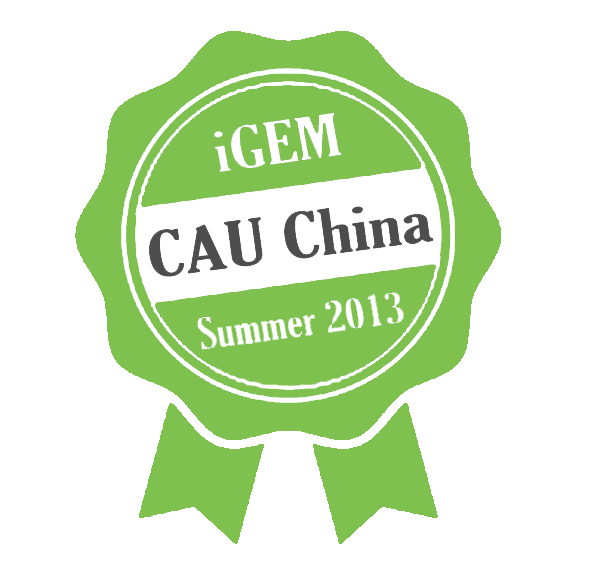Team:CAU China/Protocal
From 2013.igem.org

|
Experimental procotol Material, reagent and apparatus 1. Gene and plasmid (1) adh1 from Neurospora crassa (Nadh1, cDNA, gift from He lab); (2) adh2 from Saccharomyces cerevisiae (Sadh2, cDNA, gift from Lou lab); (3) ta0841 from Thermoplasma acidophilum (ta0841, commercially synthesized CDS, BGI Crop.); (4) expression vector pET-28a(+) (Novagen) 2. Bacteria strain E.coli DH5α, JM109, BL21(DE3); all are gifts from Chen lab; 3. Kit and reagent (1) Plasmid Mini-preparation Kit (BioTeke); (2) PCR kit (Takara); (3) Gel purification Kit (BioTeKe); (4) Commonly used endonucleases(Takara and NEB); (5) T4 DNA ligase (Takara); (6) LB medium, Antibiotics: Agarose, Bromophenol blue, Ethidium bromide (EB); 4. Apparatus (1) tubes, Petri dishes, spreader, knife, micropipette, tips; Bechtop; (2) DNA gel electrophoresis apparatus; UV transilluminator; (3) Incubator, Shaker; PCR thermocycler;
Procedure Part 1. Expression vector construction 1.1 Plasmid extraction We use pET-28a(+)(Novagen) to construct expression vector and this plasmid was prepared using Plasmid Mini-preparation Kit (BioTeke). Here was the protocol: (1) cullture DH5α which contains pET-28a(+) overnight in LB (plus Kan) at 37℃, 220 rpm; (2) Pipette 1ml of culture into a 1.5 ml Eppendorf tube, and pellet at 9000 rpm for 30s; (3) Repeat step (2) three times, 3 ml of culture in a 1.5 ml Eppendorf as a resullt; (4) Pipette 250 μl of P1 solution, and vortex to suspend pellet; (5) Pipette 250μl of P2 solution, and invert the Eppendorf tube slightly 6 to 10 times; (6) Pipette 400μl of P3 solution, and immediately invert the Eppendorf tube slightly 6 to 10 times; (7) Leave the Eppendorf tube at room temperature for 5 min, and centrifuge at 12000 rpm for 10min; (8) Transfer the supernatant (about 750μl) into a Mini-Spin column, and spin at 12000 rpm for 30 s; (9) Pipette 500μl of WB solution (containing ethanol) into the column, spin at 12000 rpm for 30 s and discard the liquid in the collecting tube; (10) Repeat step (9), and spin at 12000 rpm for 2 min; (11) Transfer the column onto a new collecting tube; (11) Add 50μl of sterilized H2O (65℃) into the column, and spin at 12000 rpm for 1min; the liquid in the collecting tube is the plasmid sample; (12) Mold a 1% agarose gel, load 5μl of our plasmid sample (plus 1ul of 6×loading buffer) and run the gel at constant 120V for 30 min; (13) Rinse the gel in EB solution for 5 min, and visualize at UV transilluminator to verify our plasmid sample; 1.2 PCR to amplify gene Three genes coding for alcohol dehydrogenase from different organism were amplified by PCR in our project. They are adh1 from Neurospora crassa (Nadh1), adh2 from Saccharomyces cerevisiae (Sadh2), and ta0841 from Thermoplasma acidophilum (ta0841). Template for Nadh1 and Sadh2 are the corresponding cDNA, gifts from He lab and Lou lab respectively, while that for ta0841 was a commercially synthesized coding sequence purchased from BGI corporation.PCR kit was bought from Takara corporation. Table 1 lists the reaction mixture (50 μl) and condition: Table 1: PCR Mixture in 50μl of Reaction System
1.3 Gel purification of PCR product Gel purification Kit (BioTeKe) was used to purify our product for downstream endonuclease cleavage. Next is the modified protocol: (1) Mold a 1% agarose gel, load 50μl of our PCR product (plus 5ul of 11×loading buffer) and run the gel at constant 120V for 30 min; (2) Rinse the gel in EB solution for 5 min, and visualize at UV transilluminator and cut the corresponding band; (3) Dissolve the gel in 600μl of DB solution at 65 ℃, transfer into a Mini-Spin column, and chill on ice for 2 min; (4) Centrifuge the column at 12000 rpm for 30s, discard the liquid in the collecting tube, and add 500μl of WB solution into the column; (5) Repeat step (4), spin the column at 12000 rpm for 2 min, transfer the column onto a new collecting tube; (6) Pipette 30μl of sterilized H2O (65℃), and spin the column at 12000 rpm for 1min; the liquid in the new collecting tube contains our purified PCR product; 1.4 Endonuclease cleavage
1.6 Ligation We used T4 DNA ligase (Takara) to construct expression vector, and table 3 describes the reaction system (20ul) and condition:
Table 3: T4 DNA Ligse reaction mixture (20μl)
(2) Set up double endonuclease (NEB) reaction system (table 4), and react at 37℃ for at least 1h;
Part 2.Library construction
After inserting wild-type alcohol dehydrogenase (ADH) gene into our expression vector pET-28a(+), we introduced mutations into our gene to construct a mutant library. The mutated genes were inserted into expression vector pET-28a(+) the same step as described in Part 1. This mutant constructs were then transformed into E.coli BL21(DE3) ,expressed and screened for acid resistance. Two methods were used to introduce mutations: site-directed mutagenesis and error-prone PCR, both using wild-type gene as template.Table5 is the error-prone PCR reaction system using Error-prone Kit (TIANDZ corporation):
Part 3. Protein expression and enzyme activity assay Table 6: Enzyme activity mixture (6ml)
| ||||||||||||||||||||||||||||||||||||||||||||||||||||||||||||||||||||||||||||||||||||
 "
"










